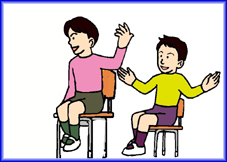![]()
Home | Crosswords | Word Searches | Flash Cards | Verbs | Songs | Creative Writing | Work Sheets | Phonics | ABCs
Survival English | Business ESL | ESL for Adults | Ask Thomas | Lesson Plans | Young Learners | Jobs |
Can I Take a Message?
A Telephone English Role-play by Chris Gunn
Materials:
Message Retieval Activity Sheet (Optional Part II)

Purpose and Audience:
The purpose of these materials is to get the students to practice taking and leaving messages over the telephone. The materials are intended for false beginners to lower intermediate students. This is also a good practical application of reported speech: He said that. . . tell her that . . . she told me that . . .
Warm-up:
After your introduction, give a few students some pieces of paper with instructions to 'call' the teacher. You can use a cell phone if you have one, or you can just use your hand and say, "Bring! Bring!" When the students ask for you, say, "Sorry. he's not here right now. Can I take a message?" and see what kind of response this gets. After trying this a few times, you can write some expressions on the board, focusing on the function of taking messages and the grammar of reported speech.
Class Set-up:
The class is divided into two groups: callers and receivers. Callers get an activity A sheet and a role card. Receivers get an activity B sheet, a will-be-back note and a name tag. Receivers sit facing the wall and callers sit behind the receivers as in the picture to the right. When a caller wants to make a call, they tap the receiver on the shoulder and say,"Bring! Bring!" Receivers put the name tag on the back of their chair so that the callers know who they are calling.

Class Activity:
Callers sit down behind the receivers, tap them on the shoulders and the conversation begins. Callers ask to talk to their friend. Receivers tell them that the friend is out and gives them the details in the 'Will Be Back' note. The receivers then ask if they can take a message. The callers leave a message. When they are finished, the callers get up to call another friend on the list.
Class Activity Part II (Optional):
After the callers have called all of their friends, they go back home and ask if there were any messages. The receivers relay the messages that they took down. Callers will need to be given the message retreival worksheet if you decide to do this optional part.
All materials (c) 2007 Lanternfish